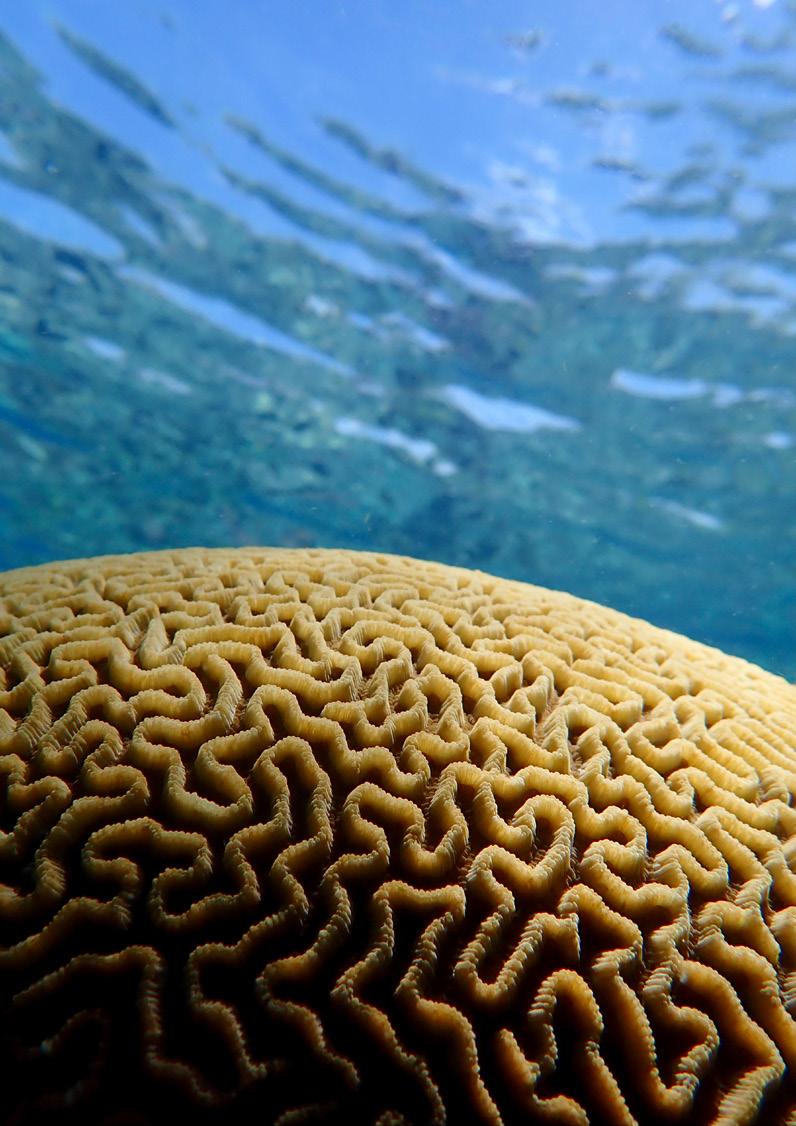
6 minute read
CROSSBREEDING ARABIAN GULF CORALS TO ENHANCE CORAL HEAT TOLERANCE
Certain reef-building corals from the Arabian Gulf may provide other corals with the gene variants needed to survive rising sea temperatures caused by global climate change.
The Arabian Gulf is the hottest region where reef-building corals live, with coral populations adapted to high temperatures from global climate change that are predicted to hit tropical reefs at the end of this century. This provides scientists with the opportunity to leverage the heat-tolerant gene variants of local reef-building corals to enhance the resilience of other coral populations.
Advertisement
Coral reefs are large underwater structures built by colonies of marine invertebrates called coral. Reef-building corals live in symbiosis with microscopic algae, which work together to extract calcium from seawater to create their hard skeletons. Coral reefs play an important role in biodiversity and human life, absorbing wave energy to protect coastlines from erosion, shielding mangrove forests and seagrass beds that serve as fish nurseries, and hosting more than a quarter of all marine fish species, including several culturally and commercially important ones.

Corals are also extremely vulnerable to ongoing environmental changes, including rising sea levels, ocean acidification, and most notably, increased water temperatures, all of which are triggered by increasing greenhouse gas emissions from human activity. The most destructive and rapid impact on coral reefs from global climate change is the bleaching and dieoffs of corals when sea temperatures are abnormally warm.
Dr. Emily Howells, Senior lecturer, Southern Cross University
Coral bleaching occurs when the sea temperature rises by just 1-2°C over the course of a few weeks, causing the coral to become stressed and expel the microscopic algae they contain. Those algae live within the coral in a mutually beneficial relationship, enabling each other to survive. If a coral is without its algae inhabitants for a prolonged period of time, it will starve and die.
As average sea temperatures have been increasing, so too have coral bleaching events. Between 2014 and 2017, it was estimated that around 75% of tropical coral reefs experienced enough heat-stress to trigger bleaching. With a recent International Panel on Climate Change report warning that global climate may rise beyond 1.5°C in the next decades, enhancing the heat tolerance of corals may assist them to adapt to the increasing temperatures.
“Reef-building corals are in global decline from the impacts of climate change and their future persistence is dependent on adaptation keeping up with the rapid rate of ocean warming. We had previously demonstrated that corals living on the hottest reefs in the world in the southern Arabian Gulf have genetically adapted to this extreme environment, where the water temperature reaches as high as 36°C, so for this study, we wanted to test whether we could transfer their beneficial genetic variants for heat tolerance to corals living elsewhere,” explained Dr. Emily Howells, who was a postdoctoral researcher at New York University Abu Dhabi (NYUAD) during the course of the project and is currently a senior lecturer at Southern Cross University in Australia.
Dr. Howells was the lead author of a paper on the project titled “Enhancing the heat tolerance of reef-building corals to future warming,” which was recently published in the leading journal Science Advances. Her co-authors included former Zayed University Associate Professor of Natural and Health Sciences Dr. David Abrego, NYUAD Associate Professor of Biology Dr. John A. Burt, Commonwealth Scientific and Industrial Research Organization research scientist Dr. Yi Jin Liew, Oregon State University Assistant Professor of Biology Dr. Eli Meyer, and King Abdullah University of Science and Technology Associate Professor of Marine Science Dr. Manuel Aranda.
The project had four broad phases. The first phase focused on study sites and coral breeding. The team collected fragments of Platygyra daedalea coral colonies from specific sites off Abu Dhabi and Fujairah, where the average sea temperatures fluctuate by 3°C in the summer. The fragments were housed and spawned in controlled environment aquaria at NYUAD, producing families of regional purebred and crossbred corals.
The second phase of the project was heat stress testing the coral offspring, which numbered more than 12,000 individual coral larvae, to find out if they could withstand the maximum temperatures of their parents’ respective locations.
“We found an immediate transfer of heat tolerance when coral eggs from Fujairah were crossed with coral sperm from Abu Dhabi. These crossbred corals showed an 84% increase in survival at high temperatures relative to purebred Fujairah corals, and they were as equally heat tolerant as purebred Abu Dhabi corals,” Dr. Howells said.
The third phase of the project comprised a field survival experiment to evaluate the influence of parental origin on survivorship in the field setting. Larval offspring from the coral families were settled onto tiles deployed near the Fujairah fragment collection site and monitored for one month.

“In this reef environment, we found that crossbred corals with Abu Dhabi fathers survive equally as well as native Fujairah purebred corals, but both had higher survival than non-native Abu Dhabi purebred corals,” shared Dr. Howells.
The fourth phase of the project was parent and offspring genotyping, which investigates the genetic constitution of an organism.
“Genome sequencing confirmed that gains in heat tolerance were due to the inheritance of beneficial gene variants from the Abu Dhabi fathers. Most Abu Dhabi fathers produced offspring that were better able to withstand heat stress, and these fathers and their offspring had crucial variants associated with better heat tolerance,” Dr. Howells said.
Explaining the implications of the project’s findings, Dr. Howells said, “These results demonstrate that corals can be selectively bred for enhanced heat tolerance using corals from populations in extreme or warmer environments which have a higher proportion of heat-tolerant genetic variants due to local adaptation.”
As a next step, she said longer-term studies are needed to evaluate any possible trade-off between thermal tolerance and other important traits in the coral. Additionally, any genetic risks involved in the introduction of selectively bred corals to populations must be identified and studied.
“Selective breeding has the potential to be used to enhance the resilience of targeted coral populations to climate warming but requires further testing before it can be implemented in intervention and restoration programs. However, the most important actions to enhance the resilience of all coral populations are those that limit the magnitude of climate change and other pressures,” Dr. Howells clarified, emphasizing the need for continued global climate change mitigation efforts.









